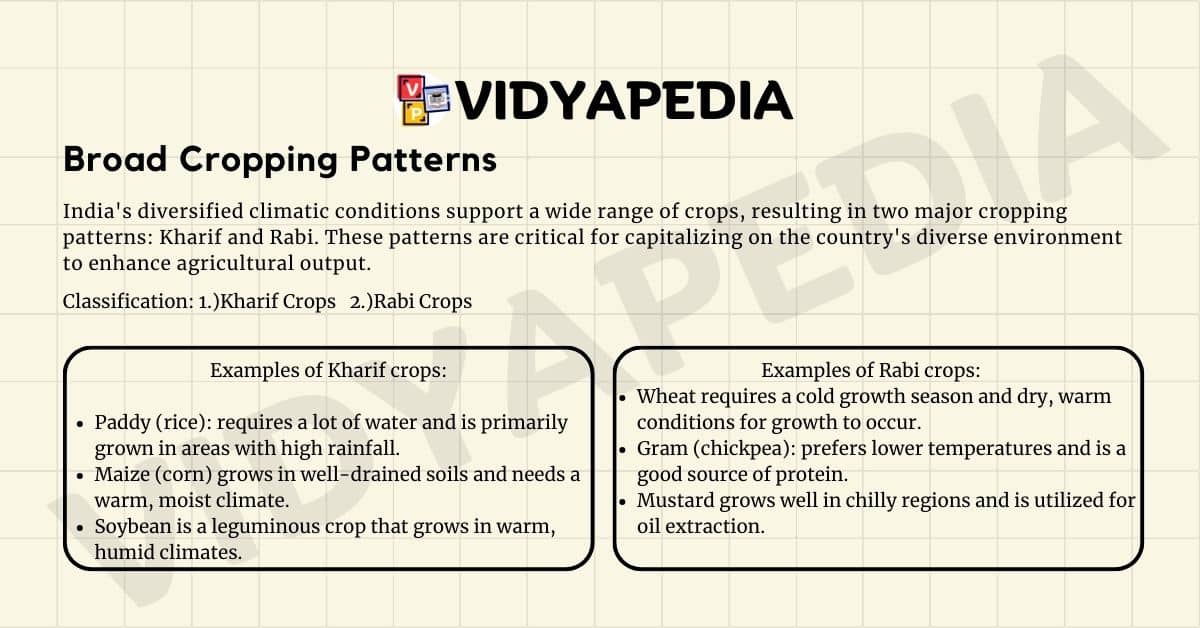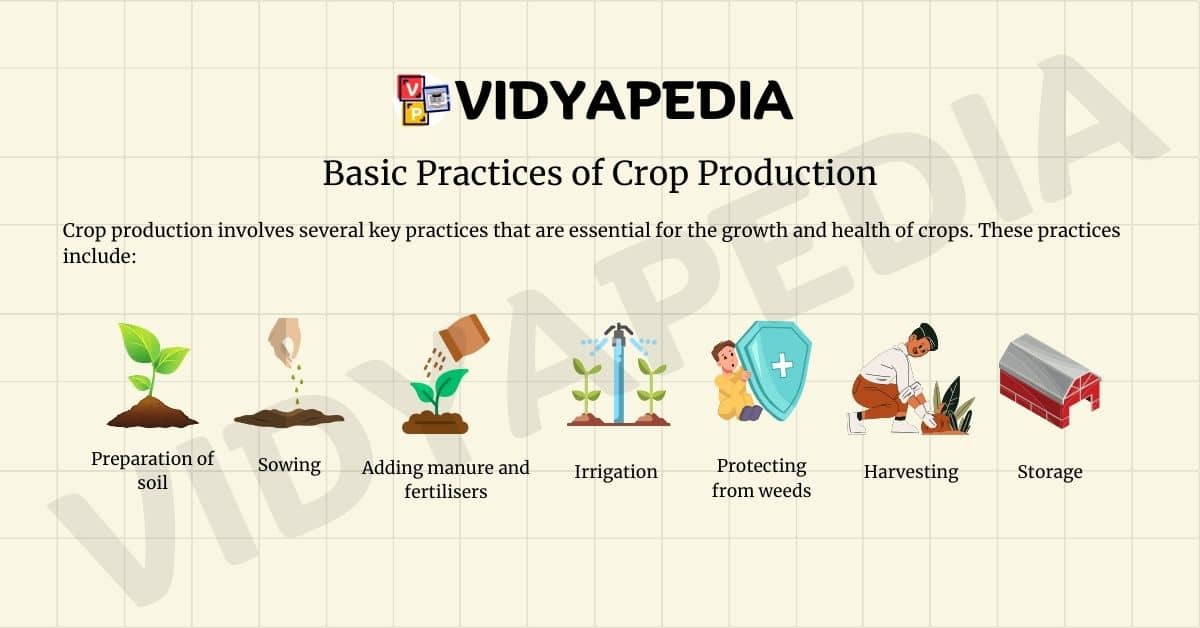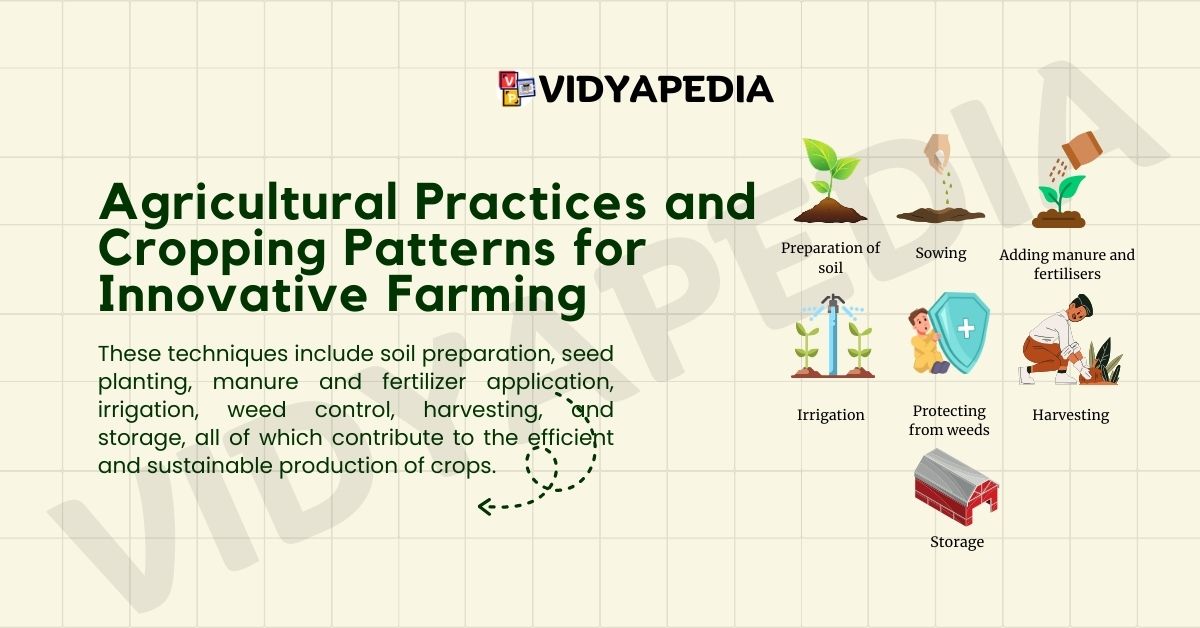Agricultural practices have been the foundation of human civilization since roughly 10,000 B.C.E., when humans initially established and cultivated land. This transformation encouraged the cultivation of essential food crops like rice and wheat, resulting in stable communities and the growth of agriculture. Agriculture methods have evolved throughout time and are now important for feeding a growing global population.
These techniques include soil preparation, seed planting, manure and fertilizer application, irrigation, weed control, harvesting, and storage, all of which contribute to the efficient and sustainable production of crops.
Broad Cropping Patterns

India’s diversified climatic conditions support a wide range of crops, resulting in two major cropping patterns: Kharif and Rabi. These patterns are critical for capitalizing on the country’s diverse environment to enhance agricultural output.
Classification
The classification of crops in India is primarily based on the season in which they are grown. The two main categories are:
- Kharif Crops
- Rabi Crops
Kharif Crops
Kharif crops are planted during the rainy season, which usually lasts from June to September. These crops grow in wetter conditions due to monsoon rains. The prime growing season for Kharif crops occurs at the beginning of the monsoon, and they are typically harvested in the autumn.
Examples of Kharif crops:
- Paddy (rice) requires a lot of water and is primarily grown in areas with high rainfall.
- Maize (corn) grows in well-drained soils and needs a warm, moist climate.
- Soybean is a leguminous crop that grows in warm, humid climates.
Rabi Crops:
Rabi crops are grown in the winter weeks, from October to March. These crops need less heat and are often harvested in the spring. Rabi crops begin to grow after the monsoon has left, taking advantage of the remaining soil moisture.
Examples of Rabi crops:
- Wheat requires a cold growth season and dry, warm conditions for growth to occur.
- Gram (chickpea): prefers lower temperatures and is a good source of protein.
- Mustard grows well in chilly regions and is utilized for oil extraction.
Basic Practices of Crop Production or Agricultural Practices

Crop production involves several key practices that are essential for the growth and health of crops. These practices include:
- Preparation of soil
- Sowing
- Adding manure and fertilisers
- Irrigation
- Protecting from weeds
- Harvesting
- Storage
Soil preparation
Soil preparation is important for the efficient production of crops. Mixing and loosening the soil allows for more root growth and circulation. Tilling or ploughing with instruments such as wooden or iron ploughs breaks up soil clumps and brings nutrient-rich soil to the surface, which is essential for good plant growth.
Sowing
Sowing is the process of implementing seeds in the soil. This requires the picking of high-quality, healthy seeds with a high yield capacity. Seeds are frequently distributed with ancient tools or modern seed drills, which provide consistent seed distribution and proper depth while preventing birds from eating the seeds.
Adding Manure and Fertilizers
Manure and fertilizers play a crucial role in enhancing soil fertility and promoting healthy crop growth. Manure is an organic substance derived from decomposed plant and animal matter. It helps improve soil texture and water retention, making it more suitable for growing crops. On the other hand, chemical fertilizers like urea and superphosphate are rich in specific nutrients that plants need. However, these should be used carefully to prevent soil degradation and water pollution.
Irrigation
Irrigation is the practice of supplying water to crops at regular intervals to ensure they receive the necessary moisture for growth. The method and frequency of irrigation depend on factors such as the type of crop, soil, and season. Traditional irrigation methods include using wells and canals. Modern techniques like sprinklers and drip irrigation are more efficient as they optimize water use and ensure even distribution across the fields.
Protecting from Weeds
Weeds are unwanted plants that compete with crops for nutrients, water, and sunlight, affecting their growth. Removing weeds, a process known as weeding, is essential for maintaining healthy crops. This can be done manually with tools like hoes or chemically using weedicides. Weedicides target weeds without harming the crops, making them an effective solution for weed control.
Harvesting
Harvesting is the process of cutting and gathering mature crops from the field. The method of harvesting can vary based on the crop type and scale of production. It can be done manually using tools like sickles or with machines such as harvesters and combines. These machines not only cut the crops but also separate the grains from the chaff through a process called threshing.
Storage
Proper storage of harvested crops is vital to prevent spoilage and loss. Grains must be dried to reduce their moisture content before storage to protect them from pests and microorganisms. Traditional storage methods include using jute bags and metal bins. For large-scale storage, silos and granaries are used, often with chemical treatments to ensure long-term preservation and protect the grains from infestations.
Frequently Asked Questions
Why are manure and fertilizers added to the soil?
Manure and fertilizers are added to the soil to replenish nutrients and enhance soil fertility, promoting healthy crop growth.
What is manure, and how does it help in crop production?
Manure is an organic substance derived from decomposed plant and animal matter. It improves soil texture and water retention, making the soil more suitable for crops.
Why should chemical fertilizers be used carefully?
Chemical fertilizers like urea and superphosphate should be used carefully to avoid soil degradation and water pollution.
What is irrigation, and why is it important?
Irrigation is the practice of supplying water to crops at regular intervals, ensuring they receive the necessary moisture for growth.
What is harvesting, and how is it done?
Harvesting is the process of cutting and gathering mature crops. It can be done manually with tools like sickles or with machines such as harvesters and combiners.


